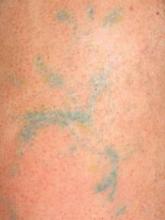DANA POINT, CALIF. – When it comes to removing unwanted tattoos with lasers, repetitive treatments on the same day appear to expedite tattoo clearance compared with a single treatment, a small study has shown.
Dr. Suzanne L. Kilmer discussed results from a study that she conducted with her associate, Dr. Omar Ibrahimi, that examined the effect of repetitive laser treatments on 17 patients who had a total of 26 tattoos among them. Of the 26 tattoos, 15 were divided into a grid that received one, two, three, or four laser treatments on the same day, while the remaining 17 were bisected and received one or four treatments in the same day, she said at a meeting sponsored by SkinCare Physicians and Northwestern University.
The researchers performed the treatments with a 755-nm Q-switched alexandrite laser or with a 532-nm and 1,064-nm Nd:YAG laser. Patients who underwent multiple treatments waited a minimum of 20 minutes between treatment sessions.
Dr. Kilmer, who heads a laser and skin surgery group practice in Sacramento, reported that lesion clearance on tattoos that had undergone multiple treatments on the same day "was clearly better" than on those receiving a single treatment on the same day. For example, at 1-month follow-up, the clearance rate jumped from 36% with one treatment to 50% for two same-day treatments, but the improvement was less pronounced with same-day treatments four and five (55%, and 59%, respectively).
Patients noted increased swelling with multiple same-day treatments "but there was no increase in pain," said Dr. Kilmer. "In fact, most felt less pain with subsequent treatments. There was no difference in post-inflammatory hyperpigmentation, and no scarring was noted. All patients preferred more rapid clearance of tattoos."
Dr. Kilmer said that the clearance of Cynosure’s PicoSure 750-nm picosecond aesthetic laser in 2012 represented an important advance in tattoo treatment. Its shorter pulse duration "shatters" the target ink into tiny particles, she said. In her clinical experience the PicoSure is especially effective for resistant tattoos – often with as few as two treatments though it makes less of a dent in red ink tattoos. "Colors matter," Dr. Kilmer noted. "We thought that the PicoSure would make color indifferent, but it doesn’t. We still need red light for green ink and green light for red ink."
Dr. Kilmer disclosed that she is a member of the medical advisory board for Candela-Syneron, Living Proof, Lumenis, Miramar, Ulthera, and Zeltiq. She also has received research support from Allergan and from numerous device companies.



